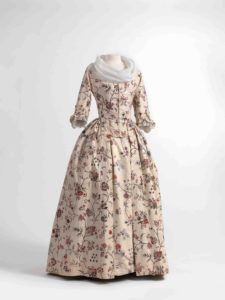Andebit et beaqui corendit, ut quostes esciendion re dit ad et prae parion es quia quas alibus sam, omnim faciden ducipidiat arum autem nobis enis es voat

18th Century Chintz Dresses

Chintz (plural of chint) is a glazed plain-woven textile made from unbleached and unprocessed cotton that contains a multi-color floral print pattern. Originally used for bed covers and draperies, the (east) Indian fabric was a major European import until a ban was enacted in a number of European counties in the early 18th century to protect local milling interests. With the import ban in place, chintz became a popular clothing fabric among French and British elite who were above the law. In 1742, a French missionary uncovered the Indian chintz-making process so that British and French mills could produce the fabric. The ban was subsequently lifted in 1759, making chintz a widely available product.







